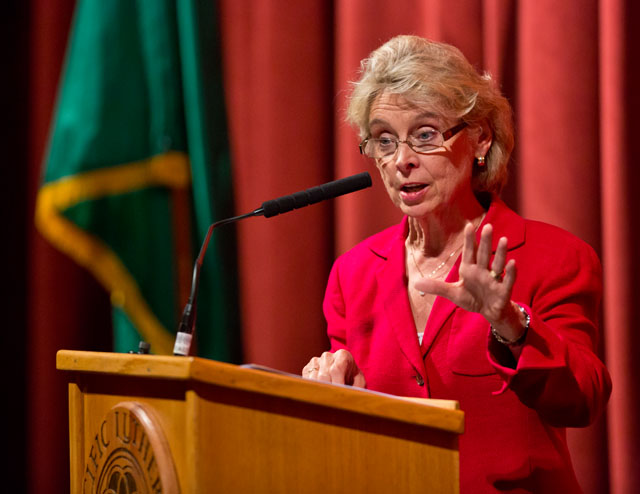Page 17 • (241 results in 0.066 seconds)
-
peanuts to a separate bag or box) Trash (often in a black/grey container labeled Landfill, or green Landfill totes, and dumpsters for Residence Halls) Anything not listed above. Some common items that are placed in recycling but are actually trash are: ALL plastic materials besides bottles, tubs and jugs (Plastic: films*, bags*, cups, lids, straws, buckets, plant pots) Plastic packing/ bubble wrap* Shredded paper Paper/ Plastic plates Paper cups Styrofoam food containers Tissues, Paper towels, and
-
“incomparable” by Alice Walker and “searingly honest” by the Washington Post.Learn More THE RACHEL CARSON SCIENCE, TECHNOLOGY & SOCIETY ANNUAL LECTURE The Case for Engineering Our Food 7:30 p.m. | Tuesday, March 6 | Anderson University Center – Chris Knutzen Hall This year’s speaker is Pamela Ronald, a distinguished professor in the Plant Pathology and Genome Center at the University of California – Davis. She also serves as founding director of the UC Davis Institute for Food and Agricultural
-
undisturbed by the building. During construction, invasive plant species were removed and the habitat was restored as a thriving ground for native plants, said John Kaniss, KPLU Construction Manager. A temporary irrigation system that was originally planned to be in for a year has already been removed, he said. “We already took that out,” Kaniss said. “What’s planted there now are native plants that are drought tolerant.” The plants will go dormant in the winter, so some grasses will look brown, but then
-
April 11, 2011 Earth Week The celebration and dedication of a student led effort to restore habitat on campus to its native state, is one of the many highlights for Earth Week at PLU. Habitat Restoration Project dedication: Senior Reed Ojala-Barbour was looking for a way to make his passion for environmental activism tangible. He found it in a habitat restoration project on PLU’s campus. The project involved clearing invasive plant species from a site on lower campus and planting native species
-

plant biology at PLU Read Next Anni Lange ’00 uses skills learned at PLU as VP of marketing and communications for Sound Physicians COMMENTS*Note: All comments are moderated If the comments don't appear for you, you might have ad blocker enabled or are currently browsing in a "private" window. LATEST POSTS Three students share how scholarships support them in their pursuit to make the world better than how they found it June 24, 2024 Kaden Bolton ’24 explored civics and public policy on campus and
-
Admission Requirements for All ApplicantsPrerequisite InformationTraditional BSN Program Prerequisites: Bio 205: Anatomy and Physiology I with lab, taken within the last 6 years Bio 206: Anatomy and Physiology II with lab, taken within the last 6 years Chem 105: Chemistry of Life (Organic and Biochemistry), taken within the last 6 years Bio 201: Microbiology with lab, taken within the last 6 years Psych 320: Developmental Psychology — Lifespan (Psych 101: Introduction to Psychology is a
-

hope to stick around the South Sound region — it’s close to home, and I like the area. I’ll take all the rain, sun and snow rather than just one or the other. Read Previous Growing into her own: how Sarah Davis ’23 discovered her passion for plant biology Read Next PLU senior and triple major Allison Sheflo discusses her PLU experience LATEST POSTS Summer Reading Recommendations July 11, 2024 Stuart Gavidia ’24 majored in computer science while interning at Amazon, Cannon, and Pierce County June 13
-
‘local’ really means, and what a plant looks like and how to care to for it.” Eventually, Mares would like to see the garden become a place where students meet and a venue for events, such as master gardening workshops, a harvest festival and musical performances. Plans are in the works to build a greenhouse, and in the future, a tool shed and gazebo. Volunteers are invited to work in the garden every Sunday from noon to 3 p.m., and donations of tools, materials or even compostable food scraps are
-
step on their find. Then it was back to work for the PLU crew, pulling for the next two hours, English Ivy, English Laurel and English Holly. You get the picture. “English” anything usually equals an invasive plant in the Northwest. “This may look like a lush environment,” Hansen said, pointing to the verdant canopy overhead. “But for the wildlife, that’s not necessarily the case.” First introduced by well meaning gardeners, the invasive shrubs and ivy quickly bully out the native vegetation
-

April 23, 2014 Former Governor Christine Gregoire talks about personal responsibility during PLU’s Earth Day celebration. (John Froschauer, Photo) Get involved, take personal responsibility and, by the way, vote, former governor says during Earth Day lecture Barbara Clements, Director of Content Development Turn off the tap. Scoop your dog’s poop. Plant a rain garden. Don’t use pesticides. Be satisfied with a blemished apple. And oh, all Pacific Lutheran University students in the audience: Run
Do you have any feedback for us? If so, feel free to use our Feedback Form.


